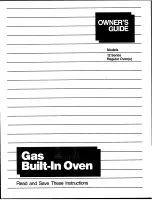
en
Tested for you in our cooking studio
20
Defrosting, heating up or cooking frozen
food
Take ready meals out of the packaging. They will heat
up more quickly and evenly in microwaveable
cookware. The different components of the meal may
not require the same amount of time to heat up.
Food which lies flat will cook more quickly than food
which is piled high. You should therefore distribute the
food so that it is as flat as possible in the cookware.
Food should not be placed in layers on top of one
another.
Always cover the food. If you do not have a suitable lid
for your cookware, use a plate or special microwave
foil.
Stir or turn the food 2 or 3 times during cooking.
After heating, allow the food to stand for a further 2 to
5 minutes to allow the temperature to even out.
This will help the food retain its own distinct taste, which
means it will require less seasoning.
Note:
Place the ovenware on the cooking compartment
floor.
Heating
:
Warning – Risk of scalding!
There is a possibility of delayed boiling when a liquid is
heated. This means that the liquid reaches boiling
temperature without the usual steam bubbles rising to
the surface. Even if the container only vibrates a little,
the hot liquid may suddenly boil over and spatter. When
heating, always place a spoon in the container. This will
prevent delayed boiling.
Caution!
Creation of sparks: Metal – e.g. a spoon in a glass –
must be kept at least 2 cm from the cooking
compartment walls and the inside of the door. Sparks
can irreparably damage the glass on the inside of the
door.
Notes
■
Take ready meals out of the packaging. They will
heat up more quickly and evenly in microwaveable
cookware. The different components of the meal
may not require the same amount of time to heat up.
■
Always cover the food. If you do not have a suitable
cover for your cookware, use a plate or special
microwave foil.
■
Stir or turn the food several times during the heating
time. Check the temperature.
■
After heating, allow the food to stand for a further
2 to 5 minutes to allow the temperature to even out.
■
Always use an oven cloth or oven gloves when
removing plates from the appliance.
Note:
Place the ovenware on the cooking compartment
floor.
Dish
Weight
Microwave output in watts,
cooking time in minutes
Note
Menu, plated meal, ready meal
(2-3
components)
300-400
g
600
W, 8-13
mins
Covered
Soup
400
g
600
W, 8-12
mins
Cookware with lid
Stew
500
g
600
W, 10-15
mins
Cookware with lid
Slices or pieces of meat in sauce, e.g. goulash 500
g
600
W, 10-15
mins
Cookware with lid
Fish, e.g. fillet steaks
400
g
600
W, 10-15
mins
Covered
Bakes, e.g. lasagne, cannelloni
450
g
600
W, 10-15
mins
Cookware without lid
Side dishes, e.g. rice, pasta
250
g
600
W, 3-7
mins
Cookware with lid, add liquid
500
g
600
W, 8-12
mins
Vegetables, e.g. peas, broccoli, carrots
300
g
600
W, 7-11
mins
Cookware with lid, add 1
tbsp of water
600
g
600
W, 14-17
mins
Creamed spinach
450
g
600
W, 10-15
mins
Cook without additional water
Dish
Amount
Microwave output in watts,
time in minutes
Note
Menu, plated meal, ready meal
(2-3
components)
600
W, 5-8
mins
-
Beverages
125
ml
900
W, ½-1
min.
Always place a spoon in the container, do not
overheat alcoholic drinks; check occasionally
while heating
200
ml
900
W, 1-2
mins
500
ml
900
W, 3-4
mins
Tested for you in our cooking studio
en
21
Cooking
Notes
■
Food which lies flat will cook more quickly than food
which is piled high. You should therefore distribute
the food so that it is as flat as possible in the
cookware. Food should not be placed in layers on
top of one another.
■
Cook the food in cookware with a lid. If you do not
have a suitable lid for your cookware, use a plate or
special microwave foil.
■
This will help the food retain its own distinct taste,
which means it will require less seasoning.
■
After cooking, allow the food to stand for a further
2
to 5
minutes to allow the temperature to even out.
■
Always use an oven cloth or oven gloves when
removing plates from the appliance.
Note:
Place the ovenware on the cooking compartment
floor.
Microwave tips
Baby food, e.g. baby bottles
50 ml
360 W, approx. ½ min
Bottles without teat or lid; shake or stir well
after heating and ensure that you check the
temperature
100 ml
360 W, ½-1 min.
200 ml
360 W, 1-2 mins
Soup, 1 cup
175 g each
600 W, 1-2 mins
-
Soup, 2 cups
175 g each
600 W, 2-3 mins
-
Meat in sauce
500 g
600 W, 7-10 mins
-
Stew
400 g
600 W, 5-7 mins
-
800 g
600 W, 7-8 mins
-
Vegetables, 1 portion
150 g
600 W, 2-3 mins
-
Vegetables, 2 portions
300 g
600 W, 3-5 mins
-
Dish
Amount
Microwave output in watts,
time in minutes
Note
Dish
Amount
Microwave output in watts,
time in minutes
Note
Whole chicken, fresh, no giblets
1200 g
600 W, 25-30 mins
Turn half way through the time
Fish fillet, fresh
400 g
600 W, 7-12 mins
-
Fresh vegetables
250 g
600 W, 6-10 mins
Cut the vegetables into pieces of equal size;
add 1 to 2 tbsp water per 100 g of vegeta-
bles;
stir while heating
500 g
600 W, 10-15 mins
Potatoes
250 g
600 W, 8-10 mins
Cut the potatoes into pieces of equal size;
add 1 tbsp water for every 100 g of potatoes;
stir while heating
500 g
600 W, 10-15 mins
750 g
600 W, 15-22 mins
Rice
125 g
600 W, 4-6 mins +
180 W, 12-15 mins
Add double the amount of liquid
250 g
600 W, 6-8 mins +
180 W, 15-18 mins
Sweet foods, e.g. blancmange (instant)
500 ml
600 W, 6-8 mins
Stir the blancmange thoroughly 2 to 3 times
using an egg whisk while heating
Fruit, compote
500 g
600 W, 9-12 mins
Stir while heating
Microwave popcorn
100 g
600 W, 3-4 mins
Always place the popcorn bag on the glass
tray;
observe the manufacturer's instructions
You cannot find any information about the settings for the quantity of
food you have prepared.
Lengthen or shorten the cooking time according to the following rule of
thumb: Double the amount = double the time, half the amount = half the time
The food has become too dry.
Next time, set a shorter cooking time or select a lower microwave power set-
ting. Cover the food and add more liquid.
The time has elapsed but the food is not defrosted, hot or cooked.
Set a longer time. Large quantities and food which is piled high require longer
times.
Time has elapsed but the food is overheated at the edge but not done
in the middle.
Stir it during the cooking time and next time, select a lower microwave power
setting and a longer cooking time.
After defrosting, the poultry or meat is defrosted on the outside but
not defrosted in the middle.
Next time, select a lower microwave output setting. Turn large amounts of
poultry or meat several times.
Summary of Contents for BF634LGS1B
Page 1: ...en Instruction manual Microwave BF634RGS1B BF634LGS1B ...
Page 2: ......
Page 23: ...6 ...




































